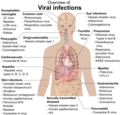Viral pathogenesis
Viral Pathogenesis refers to the process by which a virus causes disease in its host. The term is derived from the Greek words 'pathos' meaning 'suffering' and 'genesis' meaning 'origin'. Viral pathogenesis involves several stages including viral entry, replication, spread, and cell damage.
Viral Entry[edit]
The first step in viral pathogenesis is the entry of the virus into the host organism. This can occur through various routes such as the respiratory tract, gastrointestinal tract, or through breaks in the skin. The virus attaches to specific receptors on the host cell surface, a process known as viral attachment.
Replication[edit]
Once inside the host cell, the virus begins to replicate. This involves the synthesis of viral RNA or DNA, and the production of viral proteins. The replication process varies depending on the type of virus. For example, RNA viruses replicate in the cytoplasm, while DNA viruses replicate in the nucleus.
Spread[edit]
Following replication, the newly formed virus particles spread to other cells and tissues. This can occur through direct cell-to-cell contact, or through the bloodstream or lymphatic system. The spread of the virus within the host organism is known as viremia.
Cell Damage[edit]
The final stage of viral pathogenesis is cell damage or cytopathic effect. This can result from the direct effects of viral replication, or from the host's immune response. Cell damage can lead to the clinical symptoms of the viral disease.
Factors Influencing Viral Pathogenesis[edit]
Several factors can influence the pathogenesis of a virus, including the viral strain, the dose of the virus, the route of infection, and the host's immune response. Additionally, certain viruses can cause latent infection, where the virus remains dormant in the host cell for a period of time before reactivating and causing disease.
See Also[edit]
This virology related article is a stub. You can help WikiMD by expanding it.
Ad. Transform your life with W8MD's Budget GLP-1 injections from $75


W8MD offers a medical weight loss program to lose weight in Philadelphia. Our physician-supervised medical weight loss provides:
- Weight loss injections in NYC (generic and brand names):
- Zepbound / Mounjaro, Wegovy / Ozempic, Saxenda
- Most insurances accepted or discounted self-pay rates. We will obtain insurance prior authorizations if needed.
- Generic GLP1 weight loss injections from $75 for the starting dose.
- Also offer prescription weight loss medications including Phentermine, Qsymia, Diethylpropion, Contrave etc.
NYC weight loss doctor appointmentsNYC weight loss doctor appointments
Start your NYC weight loss journey today at our NYC medical weight loss and Philadelphia medical weight loss clinics.
- Call 718-946-5500 to lose weight in NYC or for medical weight loss in Philadelphia 215-676-2334.
- Tags:NYC medical weight loss, Philadelphia lose weight Zepbound NYC, Budget GLP1 weight loss injections, Wegovy Philadelphia, Wegovy NYC, Philadelphia medical weight loss, Brookly weight loss and Wegovy NYC
|
WikiMD's Wellness Encyclopedia |
| Let Food Be Thy Medicine Medicine Thy Food - Hippocrates |
Medical Disclaimer: WikiMD is not a substitute for professional medical advice. The information on WikiMD is provided as an information resource only, may be incorrect, outdated or misleading, and is not to be used or relied on for any diagnostic or treatment purposes. Please consult your health care provider before making any healthcare decisions or for guidance about a specific medical condition. WikiMD expressly disclaims responsibility, and shall have no liability, for any damages, loss, injury, or liability whatsoever suffered as a result of your reliance on the information contained in this site. By visiting this site you agree to the foregoing terms and conditions, which may from time to time be changed or supplemented by WikiMD. If you do not agree to the foregoing terms and conditions, you should not enter or use this site. See full disclaimer.
Credits:Most images are courtesy of Wikimedia commons, and templates, categories Wikipedia, licensed under CC BY SA or similar.
Translate this page: - East Asian
中文,
日本,
한국어,
South Asian
हिन्दी,
தமிழ்,
తెలుగు,
Urdu,
ಕನ್ನಡ,
Southeast Asian
Indonesian,
Vietnamese,
Thai,
မြန်မာဘာသာ,
বাংলা
European
español,
Deutsch,
français,
Greek,
português do Brasil,
polski,
română,
русский,
Nederlands,
norsk,
svenska,
suomi,
Italian
Middle Eastern & African
عربى,
Turkish,
Persian,
Hebrew,
Afrikaans,
isiZulu,
Kiswahili,
Other
Bulgarian,
Hungarian,
Czech,
Swedish,
മലയാളം,
मराठी,
ਪੰਜਾਬੀ,
ગુજરાતી,
Portuguese,
Ukrainian







